
Costa Rica is a beautiful country with great flora and fauna. We were there during the rainy season but were very lucky with the weather and hardly got wet. With temperatures of about 28 degrees centigrade / 82 Fahrenheit it was all right...
I took a lot of pictures and here only a small selection of them is shown. The rest of my photos and some photos of other group members can be seen in this photo album.
The images here have intentionally been kept fairly small. Click on a photo to see it in the photo album. There it is possible to select larger view sizes.
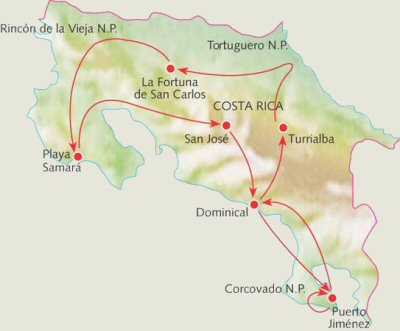
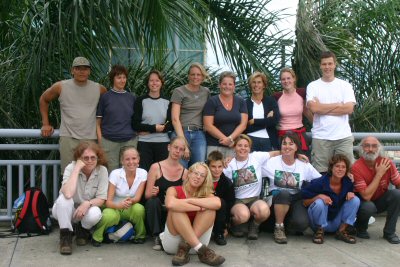
On the left a group photo is shown that was taken on the day of departure at the entrance of the airport. As you can see it was quite a woman's group...
On day 2 we left San José for what it was and went to visit the Poás
volcano. It is located 55 kilometers from the capital, and the trip
leads trough idyllic coffee fields and different vegetation zones.
The 2708 meters high volcano almost permanently blows off steam and sulfuric gasses
out of a 1.5 kilometer wide crater that is considered to be the world's largest
geyser. It has a depth of 300 meters and a sulfuric lake with constantly changing
colors (mainly green, blue, turquoise or yellow, depending on the actual chemical
composition of the lake).
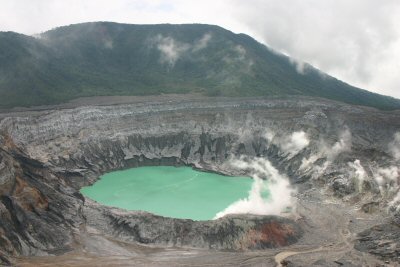
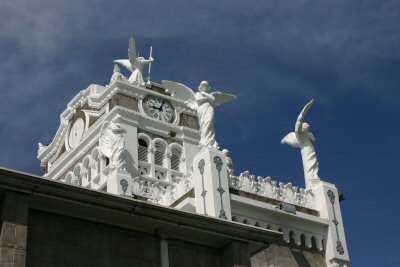
The next
day we traveled to San Gerardo de la Dota. During a stopover in Cartago we
visited the Basilica de la Virgen de Los Angeles, a Byzantine style church that
forms a national pilgrim destination.
Preparations were underway for the yearly pilgrimage were thousands of religious
people from all over the country come walking to this spot.
The lodge consisted of a beatifully constructed garden in a valley in the middle of the rainforest. Thanks to some feeders there were plenty of hummingbirds to be seen. At the end of the afternoon we made a hike to the waterfalls. The rainforest was true to its name....
Day 4 started with a hike in search of the Quetzal. The guide spotted one for us and thanks to his telescope we could take a good look at it. It turned out to be the only Quetzal we would see. Unfortunately it sat on a branch in the middle of a tree so it was very hard to photograph. Otherwise it was a nice hike through the forest and we saw other animals like beetles, frogs and lizards.
In the afternoon we left for Dominical. Our fears that the bus would not be able to get us back up the steep road were founded. Very soon we were asked to walk a short distance. But the road was steep all the way and nobody was looking forward to walk 8 more kilometers up hill in the warmth. Luckily a local Tico was found willing to transport a couple of people for a small fee, after he had dropped off his cargo. And so, nine of us were in the back of the pickup truck and four more in the front as we were driven over the bumpy road back up. From there we could continue our trip in the more comfortable bus.
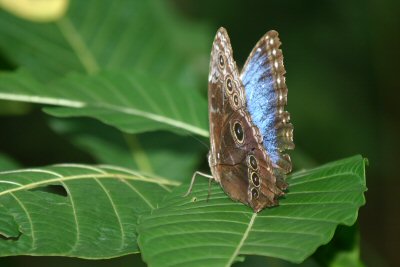
On day 5
we visited Hacienda Barú,
a private park of 330 hectare (815 acres) from Jack Ewing situated on the Pacific Coast. The
park offers a great diversity of flora and fauna, with primary and secondary rainforest,
mangrove swamp, wetlands and a nice beach. There are several hiking paths and there is an
observation tower, a butterfly garden and an orchid garden.
From the observation tower we saw a sloth, but unfortunately it isn't very clear on my
pictures. At the end of our hike a group of capuchin monkeys crossed our path. Just above
our heads they were very relaxed eating from the fruits in the trees.
The following day we were driven to Puerto Jimenez, in the extreme south of Costa Rica on the Osa peninsula. Large parts of the road up to it were pretty bad so we arrived pretty late in the gold diggers town on the Golfo Dulce.
On day 7
we continued on to Corcovado National Park. Because the roads were even worse here,
we traveled by 4x4 taxis. It was a nice trip through the rainforest. Occasionally a river
was crossed en luckily there were plenty of stops when animals where spotted. During the
trip we saw squirrel monkeys, spider monkeys, macaws and much more.
The last few kilometers to the lodge
we hiked over the beach, as there are no roads any closer. You're definitely in the middle
of nowhere!
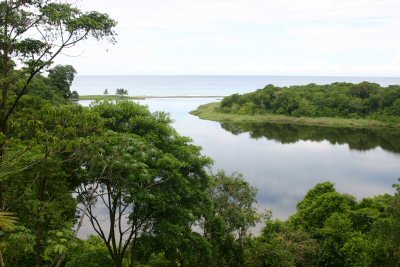
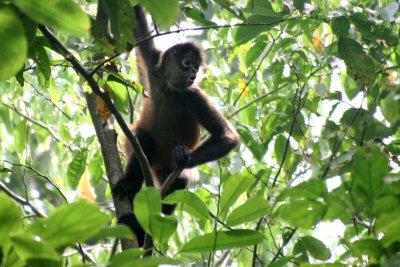
The next day
we made a long hike through the Corcovado Park. In the seventies scientists realized
that this was one of the most diverse and complex tropical rainforests in the world.
Research is still being done on all kinds of life forms, for use in new medicines amongst
others. In the park there are some 500 kinds of trees, over 140 kinds of mammals, including
tapirs and 5 kinds of cats, 367 kinds of birds, an incredible variety of insects etc.
Unfortunately we only saw a fraction of all those beautiful things.
We didn't leave Corcovado until midday.
But all morning it rained quite hard and I couldn't make myself do something.
Getting wet during a hike is one thing, but starting in the rain takes a lot more
will power...
Some tough people withstanded the rain and made a hike.
The taxis today were in a rush and the trip took considerably less time. We therefore hardly saw anything on the way. Back in Puerto Jimenez we strolled around the village, used the internet and ate something.
Next day we boarded the boat early to cross the Golfo Dulce to Golfita. From there our assigned driver Juan Carlos drove us the long way to Turrialba.
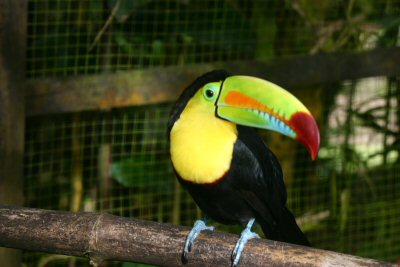
On day 11 we first visited
Guayabo.
This national monument is one of the most important and biggest archeological sites
of Costa Rica. The old ruins show a mysterious 'lost city', where from 1000 BC till
the arrival of Columbus in 1502 some 10.000 people must have lived.
This old civilization remains more mysterious than the Mayan empire. Even though
the ruins where discovered over 100 years ago, many questions are still unanswered
and even the name of this city or its inhabitants is known.
The following day
we traveled again, to Tortuguero in the northeastern part of the country at the
Caribbean Sea. We drove by the enormous banana fields of Del Monte and Chiquita.
Even though this national park is only reached after 20 kilometers of unpaved
roads and then another two hours by fast boat, it is incredibly touristy.
This area largely consists of rivers so most things happen on the river banks.
Each lodge has big boats for which goes "the faster the better".
Watching the turtles is only allowed with official guides. One of them strolls across the beach looking for turtles. Only when a turtle is actually laying eggs or returns to sea, the tourists are allowed to come in and take a close look.

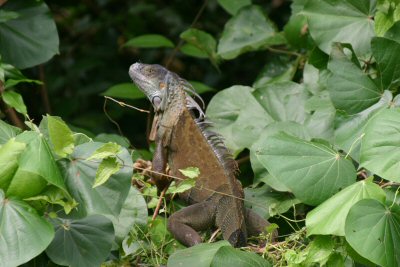
On day 13 we made some boat trips across the rivers. We again saw plenty of animals, such as kingfishers, toucans, snake birds, monkeys, iguanas, river turtles and a caiman.
We also made a hike to the Cerro de Tortuguero. From the top there is a great view on the forest, the rivers and the sea.
The next day we continued on to La Fortuna. We made a stopover at a banana packaging facility to take some pictures. Costa Rica is a big exporter of bananas.
The lodge at La Fortuna offered a great view of the Arenal volcano, one of the most active volcanos of the world. Every few minutes lava comes over the crater edge and red glowing lava chunks roll down. After diner I borrowed a camera stand and took some great photos of this very impressive sight.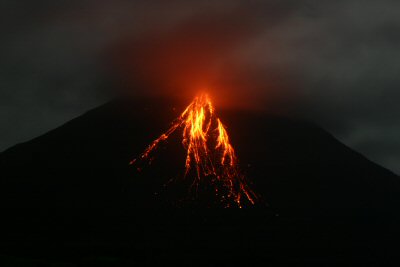
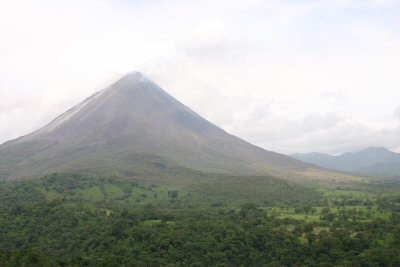
On day 15 we made a hike through the park of the Arenal volcano. Then we also made a tour over hanging bridges that occasionally offered a great view on the volcano.
The following day we drove by the enormous Arenal Lake on our way to the next lodge in Rincon de la Vieja.
On day 17 I made a long hike through the big park of the lodge. The map with trails wasn't always very clear but all in all it was a nice hike. There were several waterfalls and again I saw plenty of animals, including a couple of snakes.I passed on the thermal baths, canopy tours and horseback riding.
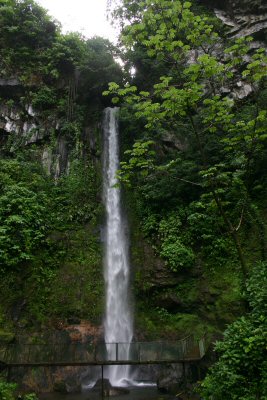
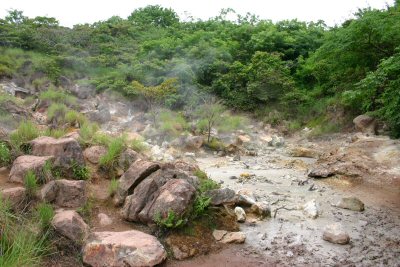
The day after we went to the Rincon de la Vieja volcano itself and hiked through its park. There is a lot of volcanic activity here in the form of hot water and mud pools. On several occasions the trails lead very close to these pools so you can take in the sulfuric vapors well...
The following day we continued on to Samara, a bathing village with a beautiful bay at the Pacific Ocean.
On day 20 we made a dolphin trip. With two boats we went out to sea. On the way we fished for tuna and caught two big ones that we took home. After an hour we saw the first dolphins. We have even seen mating sea turtles!
The weather had deteriorated badly and it was high time to head back. During the
last part it already started raining hard and it turned out the brake was very fierce.
The first boat got washed over by a big wave. Our boat decided to make a turn,
causing us to float parallel to the waves exactly when a big wave hit us. We almost
tipped over both ways. Then we fell down two meters from the top of the next wave,
causing the bench of the people in front of us to break.
The second attempt to land went better. We came close to the beach and everyone
was to jump out of the boat, being careful with the big fishing hooks on the rods
and the boat that was twisted all ways by another big wave. Luckily everyone
made it ashore in one piece.
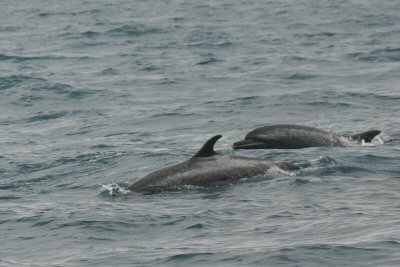
Sadly this was the end of our holiday. We were driven back to San José, to fly the next day back to Amsterdam via Miami.
I very much enjoyed this trip. Costa Rica is a beautiful country with wonderful flora and fauna. I can recommend to visit it to anyone who likes beautiful nature!
I'm glad I had a good photo camera (Canon 300D Digital Rebel) with me and a good zoom lens (Tamron 28-300; x1.6 on the Canon). I wouldn't like to miss the combined advantages of digital and lens reflex. The group members regularly came to me to watch back what we had seen that day and I could easily throw away the obviously bad pictures. And with a regular digital camera it is very hard to take nice pictures of animals.
On the left is the logo of the local beer brand, Imperial. It was a great beer that we enjoyed on quite a few occasions. After all it was a holiday and in the warmth a cold beer tastes sooo good!
Pura vida!